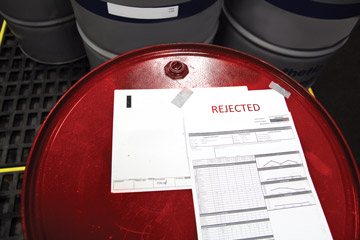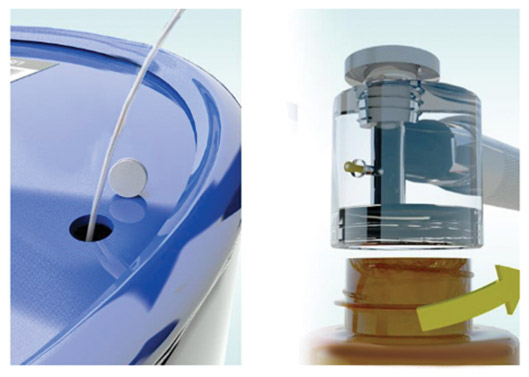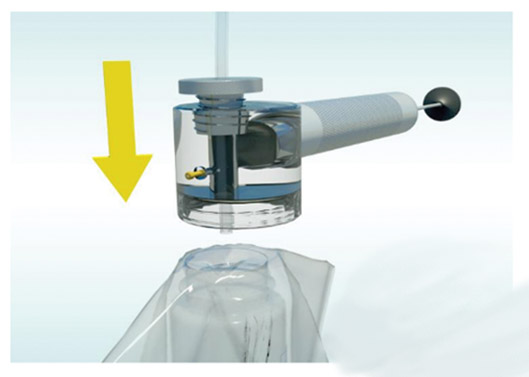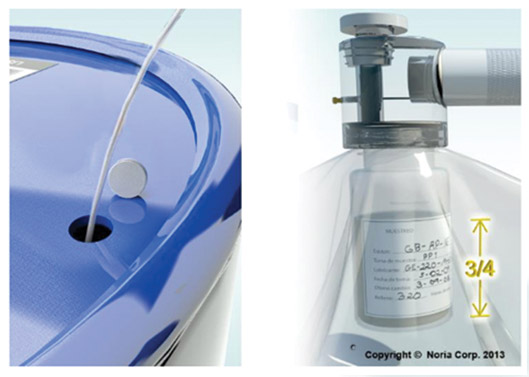Why and How to Test New Oil Deliveries

Over the past 15 years, it has been stated numerous times in Machinery Lubrication that new oil is not clean oil, and yet while visiting 12 different plants during the last six months, I discovered that not a single one of them was sampling lubricants upon receipt. Since many of these organizations filter their oils before placing them into service, they probably think this additional step doesn’t matter. However, though filtering oil will remove dirt and particles, there is so much more that could be wrong with the oils you are putting into your machines. For the sake of your plant’s reliability, please read this article and heed the recommendations that it offers.
What Is Your Acceptable Quality Limit?
In statistical process control, the term “acceptable quality limit” (AQL) refers to the worst tolerable process average that is still considered acceptable. According to Wikipedia, this is “a test and/or inspection standard that prescribes the range of the number of defective components that is considered acceptable when random sampling those components during an inspection.” These defects generally fall into three categories: critical, major and minor. The manufacturer usually determines which defects fall into which category.
What are your product quality controls? Is your AQL 95, 97 or 99.5 percent? Consider that the world’s largest oil producer has reported production rates of 241,668,000 gallons of oil per day. Even with a 99.9-percent AQL, this means that 241,668 gallons of oil produced daily would have some sort of defect. Over the course of a year, this would total more than 88 million gallons of defective oil. While I’m not alleging that oil companies are producing millions of gallons of oil that is out of specification, it is a possibility. Of course, you can’t know for certain if you don’t sample and test your oil upon receipt.
Sampling and Testing New Oils
Hopefully, you now understand why you should be sampling and testing new oils, but how can you do this? Most of the issues that occur are related to the oil’s viscosity, as opposed to the base oil type or additive mixtures, but this does not discount the benefit of a full quality test slate. Let’s begin by discussing the simplest tests that can be performed and then move to the more complex.
Viscosity
A viscosity comparison is one of the easiest tests to perform. Many viscometers can also provide quick results, which is important since the delivery person will not be willing to wait around for a long time while you sample and test the oil. Although it would be obvious if you received an ISO 220 gear oil instead of an ISO 32 hydraulic fluid, can your eyes tell the difference between an ISO 32 and an ISO 46 or 68? Granted, moving up a grade may not have much of an impact on the equipment’s operation, but going down a grade or two most certainly will. While you may not be able to distinguish between the two different viscosities, I can assure you that your equipment will.

The chart at the bottom of this page shows how a lubricant’s film thickness increases by 62 percent when the viscosity is doubled. The reverse also applies. If you cut the viscosity in half, you reduce the film thickness by a comparable amount.
Particle Counting
A particle count is another easy test to conduct prior to the acceptance of a lubricant. Again, there are many simple-to-use, quick and fairly accurate particle counters available on the market. This test can give you a good idea of how much filtration will be needed prior to adding the new oils to your equipment.
Offsite Testing
The viscosity comparison and particle count tests can and should be performed onsite prior to accepting a lubricant delivery, as they can quickly reveal if something is wrong. However, neither of these tests provides a true indication that the product in the container matches what is on the label. To accurately determine this, a series of tests must be conducted. In most cases, this level of testing will require the sample be sent offsite to a laboratory.
Trust But Verify
Some lubricant suppliers offer oil analysis as part of their services. However, I warn you to not allow the fox in the henhouse. Although many who provide testing are honorable and do a good job, unfortunately some do not. If you send a sample from a new drum of oil to your supplier, it is in their best interest to “confirm” that drum is good. Likewise, if you send a sample of in-service oil, it is in the supplier’s best interest to “determine” that it is bad and in need of changing out.
While serving in the U.S. Navy, I learned a tenet that Ronald Reagan was famous for saying: “Trust but verify.” This expression applies here as well. I would suggest having a third-party lab on standby to help keep your supplier honest. Again, most are decent and honest, but how will you know unless you follow Reagan’s advice? You don’t have to send every sample to an independent lab for verification, just enough to feel confident that the supplier is providing trustworthy analysis. I would also recommend visiting the supplier’s warehouse and laboratory if possible.
How to Draw a Proper Oil Sample
Proper oil sampling will be essential for your oil analysis program to be effective. The question then becomes how can you draw a representative sample. The procedure below outlines the best practice for drawing a sample on a static container.
Preparation
Confirm that the port identification plaque corresponds to the work order. Next, remove the plug from the tank opening and clean the exposed ports.
Hardware Flushing
Insert one end of the new nylon tubing into the tank and the other end into the vacuum pump. Do not tighten the knurled nut on the sampler to allow air to vent during sampling. Loosely thread on the purge bottle. Purge 10 times the estimated dead volume by pumping the vacuum pump. Loosen the knurled nut to stop flow and remove the flush bottle.




Sample Bottle Preparation
Open the sampling bottle. Tightly thread the sampling bottle onto the sampling pump (the nylon tubing end must puncture the bag).
Incoming Oil Test Slate
The following is a recommended slate of tests for incoming oil:
Viscosity at 40 degrees C (ASTM D445)
Viscosity at 100 degrees C (ASTM D445)
ISO particle count (ASTM D7647)
Acid number (ASTM D664, D2896, D974, D3339)
Karl Fischer moisture (ASTM D1744 or D6304)
Elemental spectroscopy (ASTM D5185, D6595)
Fourier transform infrared (FTIR) spectroscopy (ASTM E2412)
Additional Tests by Fluid Type
Compressor, Gear, R&O and Turbine Oils
Color (ASTM D1500)
Foam stability/tendency (ASTM D892)
Demulsibility (ASTM D1401, D2711)
Linear sweep voltammetry (ASTM D6810, D6971)
Hydraulic and Motor Oils
Varnish potential (ASTM D7843)
RPVOT (ASTM D2272)
Sampling
Extract the oil sample by pulling the vacuum pump handle. Fill the bottle no more than three-fourths full. Stop the oil flow by loosening the knurled nut to break the vacuum. Extract the tubing from the tank.
Labeling
Unthread the sampling bottle from the vacuum sampler and tightly secure the cap without opening the plastic bag. Write the required data on the label and attach it to the sampling bottle if not completed previously.
Cleaning
Detach the tubing and discard it. Clean the sampling pump and place it in a plastic bag. Wipe clean and reinstall the dust cap on the sampling valve. Wipe up any fluid that may have spilled on the machine. Dispose of the purged fluid, nylon tubing and any used lint-free cloth in accordance with the plant’s environmental policy.
Hold Suppliers Accountable
It is critical to your oil analysis program that you sample and test oils upon receipt. The possibility of receiving the wrong oil or lubricants that do not meet the required specifications is very real. Consider how uncomfortable you become when one of your customers is delivered the wrong product or one that is of poor quality. What are the costs involved in getting that product back and replacing it? What are the hidden costs in the damage to your relationship with your customer? How many times can you make that mistake before it affects your reputation and business? Shouldn’t you hold your vendors and suppliers to the same standard? Remember, they are not responsible for the reliability and uptime of your machines - you are. To fulfill this responsibility, you must ensure that you receive clean, quality lubricants for your equipment.
